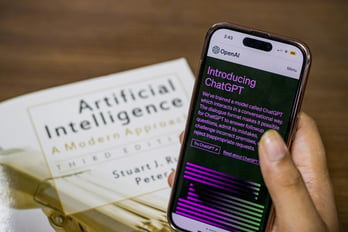One such phenomenon is AI hallucinations, where AI systems generate content that appears authentic but lacks a factual basis. Let’s look at what AI hallucinations are, the types, how they occur and how to fact-check them effectively.
Read: Explore Revolutionary Solutions with Azure AI
Understanding AI Hallucinations
As AI technologies continue to evolve, so will their sophistication in creating content. AI is powered by a large language model that teaches it to analyze vast amounts of data. From there, algorithms predict what words will follow in a sequence by finding patterns in the data, so the larger the data set, the better the responses. However, the algorithms work on probability, not accuracy, which is where hallucinations happen.
AI hallucinations refer to media, text, images, audio or videos created or manipulated by generative AI, like ChatGPT, that are inaccurate, offensive or false. These contents can be incredibly convincing and difficult to detect as they often mimic the style, tone and even voice of a real person. However, they lack the factual grounding or context that authentic content possesses, which is why it’s essential to remain vigilant and informed about the risks associated with AI hallucinations.
Relying on AI for any task where you need factual, reliable information that can’t be verified could be a problem. That’s why industries like healthcare, finance, legal and others should show caution when using AI. If they publish content with AI hallucinations, their reputation and credibility could suffer, and they could spread false or misleading information, misleading users and eroding trust. 41% of executives and developers are worried that AI will generate errors and hallucinations instead of facts.
How Do AI Hallucinations Occur?
There are several reasons why AI might hallucinate:
- Insufficient, outdated or low-quality training data: An AI model is only as good as the data it’s trained on. If the AI doesn’t understand your prompt or have sufficient information to accurately answer your query, it can rely on its limited dataset to generate a response, even if it’s inaccurate. Low-quality data with flaws can cause the AI model to learn errors, biases or irrelevant information. Outdated data can struggle to understand recent developments, using obsolete references or missing new terminology and concepts.
- Overfitting: When an AI model is trained on a limited dataset, it may memorize the inputs and outputs, leaving it unable to generalize new data.
- Adversarial attacks: This is when prompts are deliberately designed to confuse or trick AI into generating incorrect, inappropriate or nonsensical responses.
Types of AI Hallucinations
- Factual hallucination: The most common hallucination type is where AI generates the wrong content even though the model makes it sound plausible and confident. An example of this is when Bard claimed that the James Webb Space Telescope was the first to take photos of space, even though the telescope launched in 2021 and the first photos were taken in 2004.
- Fabricated hallucination: This is when AI makes up false information from nothing. A recent example is when a New York lawyer was sanctioned after he used ChatGPT to write a brief, but it cited six fake cases.
- Harmful hallucination: This example is when AI creates information that can harm someone’s reputation or offend them. For example, ChatGPT claimed that a professor sexually assaulted a student while on a class trip, except the trip never took place and the professor was never accused.
Fact-Checking AI-Generated Content
Given the proliferation of AI-generated content, it’s crucial to develop robust strategies for fact-checking and verifying the authenticity of information. Staying informed and vigilant is the key to mitigating the impact of AI misinformation on society.
- Verify: Look for reliable sources and cross-reference the AI content with trustworthy news outlets or authoritative websites. You can also use fact-checkers like Google Fact Check to verify facts and figures.
- Analyze context: Pay attention to the context in which the information is present and the plausibility of any statements or claims. AI-generated content may lack nuanced understanding or real-world context, leading to inconsistencies or inaccuracies.
- Use critical thinking: Cultivate a habit of critical thinking when consuming information online. Question the validity of claims, scrutinize evidence and seek multiple perspectives before forming conclusions.
Thriveon and AI
At Thriveon, we understand the importance of embracing the modern workplace. That’s why implementing technologies like Microsoft Teams and AI is crucial for businesses wanting to stay ahead of the competition. We can help companies utilize AI but be mindful in how they use it.
Schedule a meeting today for more information.

